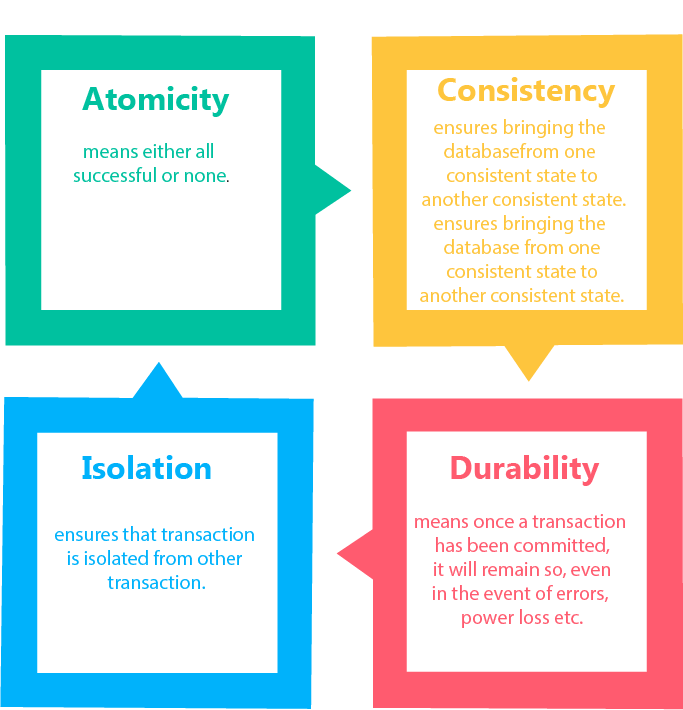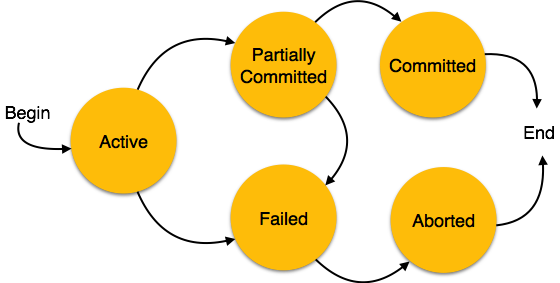transaction in dbms : ACID properties are a set of database transaction properties that are intended to guarantee validity even in the event of an error, power failure, etc. ACID Properties makes your transactions secure and consistent. ACID Properties ensure that the database and transactions are free from conflicts and errors.
In this article we will discuss in detail about database transaction and ACID properties and we will also learn about DBMS Concurrency control and Transaction. If you are preparing for database companies then by reading this article you can find lots of interview questions on this topic.
Relational databases like MYSQL, PostgreSQL have ACID properties. If we talk about NoSQL database, MongoDB 4.0 also supports ACID for multi document transaction.
What is Database? & transaction in dbms
What is database? Database is a platform where we can keep data for future reference. A database is a collection of interrelated data. Each entry in the database is referred to as a record in database terminology. A data field, or simply a field, is the amount of information contained in each record. Each area has a different name that is used to identify it. Each entry occupies a fixed place in the database.
What is Database Transaction?
transaction in dbms : Transaction is the basic thing that defines the database transaction. In other words, if we talk in terms of database then transaction is a collection of instructions, all transaction must follow ACID properties. ACID properties help in maintaining the integrity of the database.
A transaction is a set of several actions. In which there are many stages and each stage has its own separate function.
There are two types of transactions:
- Implicit Transactions
- Explicit Transactions
Example of transaction in dbms, transfer of money from one bank account to another bank account. If we debit money from one account and deposit it in another account, then the whole process is a single transaction.
ACID Properties are divided into four properties: Atomicity, Consistency, Isolation, and Durability.
ACID Properties in DBMS with Examples
So far we have learned that ACID properties are divided into four properties. Let us know each in detail and with examples.
atomicity
All changes to the database are done in a single operation. That is, all changes should be made simultaneously or not at all. In other words, the transaction must be executed completely or completely failed, if one part of the transaction fails, then all the transactions will fail.
For example – In a money transfer transaction, both debit and credit should occur simultaneously or not at all.
Consistency
The database must be in a consistent state after any transaction.
There should be no change in the data in the database after the completion of the transaction except those changes which we have made intentionally.
Isolation
When more than one transaction is executed simultaneously, one transaction should not affect the other.
Durability
If the transaction is completed and the data is committed, the changes should remain in the database permanently even after a software and system failure.
For example, in an application that transfers money from one account to another, this property ensures that changes made to each account cannot be reversed.
Any transaction should have the above four characteristics. Some of these properties can be changed depending on the situation in it. In this one transaction cannot affect any other transaction, that is what is Isolation Property.
transaction in dbms : Let’s take demo of a easy transaction in dbms. Suppose a bank students transfers Rs 800 from John’s account to kiyan’s account. This very easy as well as tiny transaction involves several low-level tasks.
John’s Account
Open_Account(John) Old_Balance = John.balance New_Balance = Old_Balance - 800 John.balance = New_Balance Close_Account(John)
kiyan’s Account
Open_Account(kiyan) Old_Balance = kiyan.balance New_Balance = Old_Balance + 800 kiyan.balance = New_Balance Close_Account(kiyan)
Also you can read : metadata in dbms
Transaction in dbms
| Operations | Descriptions |
| Retrive | To retrive data stored ina database. |
| Insert | To store new data in database. |
| Delete | To delete existing data from database. |
| Update | To modify existing data in database. |
| Commit | To save the work done permanently. |
| Rollback | To undo the work done. |
Types of Transactions
Based on Application areas
- Compensating transactions
- Non-distributed vs. distributed
- On-line vs. batch
- Transactions Timing
ACID Properties [Property of Transaction]
- Atomicity
- Consistency
- Durability
- Isolation

States of Transactions

Example of Transaction Management
Transfer of 100₹ from Account Syam to Account Dev. Initially Syam= 600₹, Dev= 900₹. This data is brought to John from Hard Disk.
R(Syam) -- 600 // Accessed from John. Syam = Syam-100 // Deducting 100₹ from Syam. W(Syam)--500 // Updated in John. R(Dev) -- 900 // Accessed from John. Dev=Dev+100 // 100₹ is added to Dev's Account. W(Dev) --1000 // Updated in John. commit // The data in John is taken back to Hard Disk.
Advantages of following ACID Properties.
in transaction in dbms, This property of ACID prevents data loss during a system failure, such as error and power failure.
FAQ – ACID Properties in DBMS
What are the types of transaction status under Atomic Property?
There are two types of success and failure, ie success and failure transaction in dbms.
What are the commands related to Transaction?
BEGIN Transaction, SAVE Transaction, COMMIT Transaction and ROLLBACK Transaction
What does the ACID property ensure?
Even complex transactions will be self-contained and reliable due to ACID features.
Which databases support transactions?
Transactions are fully supported by modern data sources such as MSSQL Server, Oracle, and DB2.
Note: transaction in dbms However, ACID properties are the most important part of using the database. In applications these days a database can be very large, thousands of networked computers can be used to connect to the database, and maintaining ACID is not very feasible. And the database performance may not be what you want.